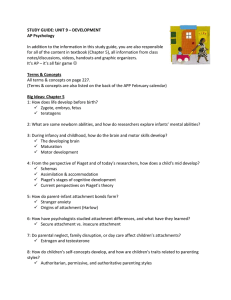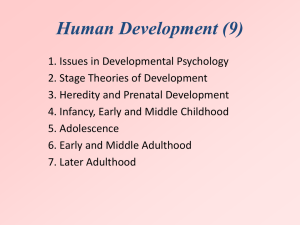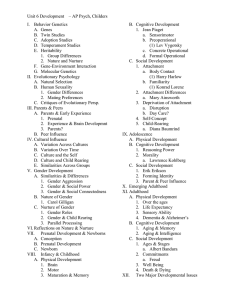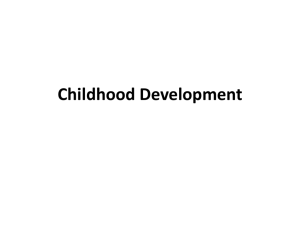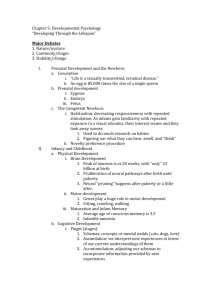Discuss one theory of cognitive development - rcook
advertisement
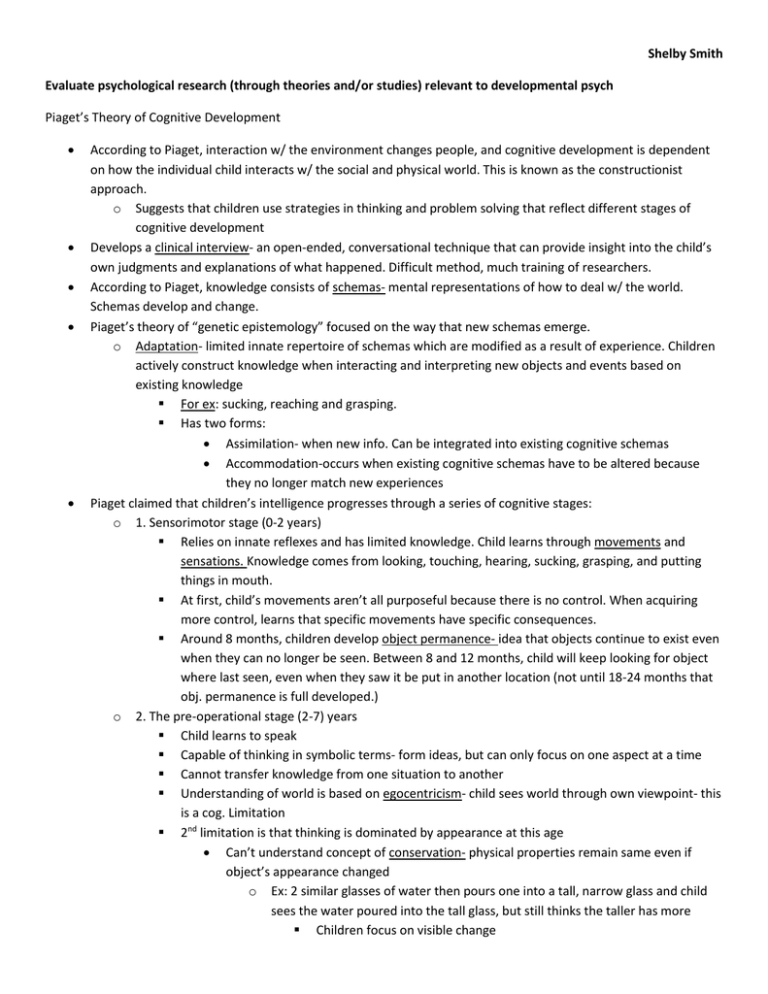
Shelby Smith Evaluate psychological research (through theories and/or studies) relevant to developmental psych Piaget’s Theory of Cognitive Development According to Piaget, interaction w/ the environment changes people, and cognitive development is dependent on how the individual child interacts w/ the social and physical world. This is known as the constructionist approach. o Suggests that children use strategies in thinking and problem solving that reflect different stages of cognitive development Develops a clinical interview- an open-ended, conversational technique that can provide insight into the child’s own judgments and explanations of what happened. Difficult method, much training of researchers. According to Piaget, knowledge consists of schemas- mental representations of how to deal w/ the world. Schemas develop and change. Piaget’s theory of “genetic epistemology” focused on the way that new schemas emerge. o Adaptation- limited innate repertoire of schemas which are modified as a result of experience. Children actively construct knowledge when interacting and interpreting new objects and events based on existing knowledge For ex: sucking, reaching and grasping. Has two forms: Assimilation- when new info. Can be integrated into existing cognitive schemas Accommodation-occurs when existing cognitive schemas have to be altered because they no longer match new experiences Piaget claimed that children’s intelligence progresses through a series of cognitive stages: o 1. Sensorimotor stage (0-2 years) Relies on innate reflexes and has limited knowledge. Child learns through movements and sensations. Knowledge comes from looking, touching, hearing, sucking, grasping, and putting things in mouth. At first, child’s movements aren’t all purposeful because there is no control. When acquiring more control, learns that specific movements have specific consequences. Around 8 months, children develop object permanence- idea that objects continue to exist even when they can no longer be seen. Between 8 and 12 months, child will keep looking for object where last seen, even when they saw it be put in another location (not until 18-24 months that obj. permanence is full developed.) o 2. The pre-operational stage (2-7) years Child learns to speak Capable of thinking in symbolic terms- form ideas, but can only focus on one aspect at a time Cannot transfer knowledge from one situation to another Understanding of world is based on egocentricism- child sees world through own viewpoint- this is a cog. Limitation 2nd limitation is that thinking is dominated by appearance at this age Can’t understand concept of conservation- physical properties remain same even if object’s appearance changed o Ex: 2 similar glasses of water then pours one into a tall, narrow glass and child sees the water poured into the tall glass, but still thinks the taller has more Children focus on visible change o 3. The Concrete Operational Stage (7-12) Formal schooling Use some rules of logic in problem solving- only concrete tasks Problem solving is generally random and not systematic o 4. Formal operational stage (from age 12) Use formal, abstract logic Mental manipulate ideas, concepts, or numbers and can think hypothetically Approach problem in systematic way Piaget believed that everybody reaches the formal operational stage when they are 20, but modern research has demonstrated that it depends on education to a large extent Evaluations o Theory is very influential, especially in primary schools o Changed tradition view of children as passive, suggesting that children are active in searching out knowledge and constructing mental representation of the world o Suggested inventive research representations of the world o Limitation in explanation: Methodology-small sampling, mainly his own children were used Cultural bias o Arguable that Piaget underestimated children’s cognitive abilities Jeffrey Taboada Outline physical changes in adolescences. Discuss how such physical changes during adolescences relate to development of identity. Adolescence, in modern industrial societies, is the transition from childhood to adulthood. It lasts from age 11 or 12 until the late teens or early twenties. Physical changes in adolescence: Puberty is triggered by hormonal changes, which may affect moods and behavior. Puberty takes about four years, typically begins earlier in girls than in boys, and ends when a person can reproduce. A secular trend toward earlier attainment of adult height and sexual maturity began about 100 years ago, probably because of improvements in living standards. During puberty, both boys and girls undergo an adolescent growth spurt. Primary sex characteristics (the reproductive organs) enlarge and mature, and secondary sex characteristics appear. The principal signs of sexual maturity are production of sperm (for males) and menstruation (for females). Spermarche typically occurs at age 13. Menarche occurs, on average, between the ages of 12 and 13 in the United States. Until puberty both sexes receive the same amount of testosterone and estrogen for both sex. At puberty, girls produce more estrogen, boys more testosterone. Result is a "growth spurt with increase in distribution of fat and muscle. Girls experience growth spurt 2-3 years earlier from ages 10-13 (development of breasts, widening of hips), while boys experience a broadening of shoulders, increase in muscle strength Physical changes in relation to development of identity: Legal, sociological, and psychological definitions of entrance into adulthood vary. Adolescence is full of opportunities for physical, cognitive, and psychosocial growth, but also of risks to healthy development. Risky behavior patterns, such as drinking alcohol, drug abuse, sexual and gang activity, and use of firearms, tend to be established early in adolescence. About 4 out of 5 young people experience no major problems. Psychological effects of early or late maturation depend on how adolescents and others interpret the accompanying changes. The physical changes result in an emerging sexual identity which includes learning how to handle desires, sexual attitudes and values, and integrating all of this into a new self-image Johnia Murray Evaluate theories of cognitive development Piaget’s Theory of Cognitive Development Constructionist Approach: interaction w/ the environment changes people; cognitivedevelopment dependent on how the individual child interacts with the social and physical world Suggests that children use strategies in thinking and problem solving that reflect different stages of cognitive development Knowledge consists of cognitive structures – schemas – which are representations of how to deal with the world; schemas develop or change Genetic Epistemology: focus on the way that new schemas emerge o Child’s first experiences based on limited innate repertoire of schemas which are modified as a result of experience (adaptation)(2 forms of adaptations Assimilation: happens when new info can be integrated into existing schemas Accommodation: occurs when existing schemas are altered because they no longer match new experiences Piaget’s Four Stages of Cognitive Development Stage Approx. Age (Years) Sensiormotor 0–2 Pre-Operational 2–7 Concrete Operational 7 – 12 Formal Operational 12+ Characteristics Knowledge develops as a result of sensations and actions Increase use of symbolic thought and self awareness; dominated by visual appearance of things; language development; egocentrism Logical reasoning based on real objects that can be manipulated; understand conservation Ability to use abstract reasoning and logic Vygotsky’s Sociocultural Approach to Cognitive Development Argued it’s not possible to describe the process children acquire knowledge w/o taking into account the child’s social environment or culture Theory suggest a child’s cognitive development is based on interaction w/ other people, as well as the cultural tools to understand the world provided by the child’s culture Knowledge transferred via imitation, instructions, or collaborative learning Language is primary form of interaction adults use to transmit to the child the knowledge that exists in the culture, and as the child grow older, language come to serve as the most important tool of learning. Zone of Proximal Development (ZPD) Range between the level a child can solve a problem alone and the level a child solves a problem w/ assistance from someone else. When working w/ instructor, child will work close to upper limits of capabilities Child will eventually work at high level independently As upper limit is achieved, it becomes new lower limit of child’s ZPD Mary Ainsworth o o o Conducted “Stranger Situation Test” of attachment Securely attached children will: Will explore freely while mother’s present Will engage with strangers Will be visibly upset when mother departs Will be happy to see mother return Will not engage stranger when mother isn’t in the room Insecure – avoidant: not distressed at mother leaving or stranger arriving; cool response as mother returns (caused by distant mothers) Insecure – resistant: clingy to mother; traumatized at every stage of experiment; distrustful of mothers (caused by over bearing, controlling mothers) Erik Erikson Stage Theory of Psychological/Cognitive Development Stage 1 Trust v. Mistrust From birth to 18 months Stage 2 Autonomy v. Shame From 18 months to 3 years Stage 3 Initiatiave v. Guilt From 3 to 6 years Stage 4 Competence v. From 6 to 12 years Inferiority Stage 5 Identity v. Role From 12 to 18 years Confusion Stage 6 Intimacy v. Isolation From 19 to 40 years Stage 7 Generativity v. From 40 to 65 years Stagnation Stage 8 Ego Integrity v. Despair From 65 years to Death Feeding is the major event Toilet training, feeding, and self dressing Independence Attendance at school Establishing peer relationships Love relationships Parenting Acceptance of one’s life Failure to address and resolve a developmental challenge results in conflict throughout childhood Lawrence Kohlberg o o o o o Stage Theory of Moral Development We make moral decisions based on “ethic of justice” 4 – 10 yrs: Preconventional: Avoid punishment and gain reward 10 – 13 yrs: Conventional: gain approval and avoid disapproval from others; duty and guilt Age 13+: Post Conventional: agreed upon rights and personal moral standards Imani Ross Discuss potential effects of deprivation or trauma in childhood on later development. / Discuss psychological research (theories and or studies) related to the potential effects of deprivation or trauma in childhood on later development. As a child there are events that occur that are vital to a successful and healthy adult life. These events are influenced by factors such as having loving individuals around, good nutrition, conversation, and physical and mental stimulation A child that has to grow up without an adequate supply of all or some of these factors can have serious developmental issues Deprivation in childhood can be seen as living in a state of various forms of neglect to provide basic needs – physical, emotional, or social. Deprivation is often related to institutionalization, growing up in poverty, and parental problems (e.g. alcoholism or mental illness. Trauma in childhood can be seen as experiencing a powerful shock (e.g. divorce, death of a parent, physical or sexual abuse, natural disasters, or war. Such experiences may have long-lasting effects on development. It is not possible to make a clear-cut distinction between effects of deprivation or trauma: they are much the same. Experiences of deprivation can also be traumatizing for the child. Potential effect of trauma: PTSD Children who have experienced severe and repeated trauma may develop post-traumatic stress disorder (PTSD), which could interfere with normal development. If left untreated children may exhibit impulsivity, agitation, hyper-vigilance, avoidance behavior, and emotional numbness. Carion et al. (2009) performed fMRI scans and found that children suffering from PTSD after experiencing extreme stressors such as abuse or witnessing violence performed worse on a simple verbal memory test and showed less hippocampal activity compared to a control group. The participants who performed worst on the test were those who also showed specific PTSD symptoms such as withdrawal from those who wanted to help them. They also had difficulties remembering the trauma, felt cut off from others, and showed lack of emotion. Yehuda et al. (2001) studied the mental health of 51 children of Holocaust survivors who were raised by traumatized parents and made comparisons to a control group. The mean age of the sample was 40.9 years. The results showed that children of Holocaust survivors were more likely to develop PTSD (33.3 % compared to 12.2% in the control group). Childhood trauma was associated with parental PTSD and the results indicate that PTSD can be transmitted from parent to child. Potential effects of deprivation: cognitive impairment and attachment disorder This is a longitudinal study of 324 Romanian adoptees that entered the UK between February 1990 and September 1992. The aim was to investigate potential long-term effects of severe deprivation in childhood. All the children had been reared from infancy in very deprived institutions in Romania and adopted into UK families at various ages up to 42 months. Rutter et al. (2004) investigated a sample of 144 children who were, at that time, six years of age. The parents were interviewed at home and answered questionnaires on the family and the child’s behavior. Three months later the child was assessed using observations and standard cognitive and developmental measures including tests on general cognitive functioning and attachment behavior. The focus was on cognitive impairment and attachment disturbance in children who had spent more than six months in the institutions. The study found no major deficits in children who had spent less than six months there. Attachment disorder Data was collected in semi-structured interviews with parents to assess the child’s behavior toward the parent and other adults in both novel and familiar situations. There was a relationship between length of institutional deprivation and attachment disorders. No significant deficits were found in the children who entered the UK below the age of six months. A number of children showed an insecure attachment pattern called disinhibited attachment disorder or Reactive Attachment Disorder characterized by: lack of preference for contact with caregivers versus relative strangers (i.e. lack of differentiation among adults) definite lack of checking back with the parent in anxiety provoking situations. Sources http://www.appsychology.com/IB%20Psych/IBcontent/Options/Developmental/Dev%20Questions/4%20Dev.ht m For an AMAZING PowerPoint that outlines this question really well http://www.google.com/url?sa=t&rct=j&q=&esrc=s&source=web&cd=2&ved=0CC0QFjAB&url=http%3A%2 F%2Fwww.appsychology.com%2FIB%2520Psych%2FIB%2520PP%2FHLPP%2FDevelopmental%2F4%2520 Trauma%2520and%2520Development.pptx&ei=SGUvU7TGOIq80AHI8IGQAQ&usg=AFQjCNGR_OiEs6NomySDxntqj-1UyEQtg Jan’Tavia Werts Discuss how sociocultural factors influence the formation and development of gender roles. Family (Maccoby, 1993) Children who experience the security of loving parents, have strong attachements. This makes them more able to reach out to others and relate. They use the relationship of their parents as a support to venture out and explore their environment. They reach out to others and return to their parent for support just to venture out further into the social world of their environment (Ainsworth et al., 1978). As they expand out into the work they are likely to learn and experience from their social interactions. (Dorsey, 2003) Authoritative Parenting Parents that have rules and they expect the child to follow them. These parents also listen to their children. If the child were to get into trouble they would listen to the child's side and base a punishment off of their actions and reasoning. Authoritarian Parenting Parents that have the motto "because I said so," these parents do not listen to their children and expect things to be done when said. Their children are usually over obedient and proficient, or the opposite and become delinquent. They act as so because they are unhappy; the parents intentions were to make their kids successful in life. Permissive Parenting These parents have very few rules and treat their children as if they were their friend. These rules are barley enforced and the child has no sense of wrong and right. In later years the child will become reserved because they do not know how to act around others. Dismissive Parenting Parents are totally unresponsive to their children, leaving the child to fend for themselves emotionally. These children grow up quicker than needed and often have behavioral issues in school. They do worse academically and remain socially and emotionally isolated. Gender Fathers are more likely to engagewith their son who's interested in sports related things. Sandra Bem,1981 Gender schema theory: a cognitive theory that explains how individuals become gendered in society, and how sex-linked characteristics are maintained and transmitted to other members of a culture. According to this theory, gender-associated information is predominantly transmitted through society by way of schemata, or networks of information that allow for some information to be more easily assimilated than others. http://www.education.com/reference/article/factors-affecting-social-development/ http://www.theartofbehavior.com/how-were-you-raised-the-4-types-of-parenting-styles/ https://www.boundless.com/psychology/gender-and-sexuality/introduction-to-gender-andsexuality/gender-identity-development/ Amanda Pinto Define attachment. Discuss how childhood attachment may affect the formation of relationships later in life. Introduction Attachment behavior: babies seek proximity to the mother and react with anxiety to separation John Bowlby believed that attachment was an innate pattern and that it helped infants to survive. Internal working model: cognitive schema of expectations concerning attachment figures. Has three important elements: o Ideas about attachment figures and what can be expected from then o Ideas about the self o Ideas about how the self and others relate Attachment theory assumes that the internal working model continues through the lifespan. o Research indicates this is relatively stable, although they can be modified. First Study Ainsworth 1967 and 1971 o o 1967: Longitudinal study carried out in Uganda using home visits and natural observations of mother-child interactions in a strange situation 28 unweaned babies. Study began with ages of 15 weeks to 2 years. Observed every two weeks for two hours at a time for nine months At the end of the study, she classified the babies unto three attachment groups based on their reactions in a strange situation and found they correlated with the mothers sensitivity 1971 Replicated the Uganda study in Baltimore 26 infant-mother pairs who were visited every 3-4 weeks for the first year of the babies life Found the same distribution of attachment patterns Types of Attachment based on Ainsworths Strange Situation Classification o Type A: Avoidant 20% of children Child shows indifference when mother leaves room and avoids contact with her when she returns o o Child is apparently not afraid of strangers Mother tends to be insensitive and do not seem interested in children's play Type B: securely attached 70% of children Child is upset when mother leaves and happy to see her again Child is easily comforted by their mother Mothers are very interested in their childs play and actively support play and communicate with the children during play Type C: Ambivalent 10% of children Child is upset when mother leaves room and has difficulty soothing child when she returns Child seeks comfort but at the same time rejects it Mothers tend to be inconsistent in their reactions toward their children Second Study Hazan and Shaver (1987) explored attachment theory in relation to adult relationships. Found it a very valuable perspective on adult love because it could explain positive emotions (caring, intimacy, trust) as well as negative emotions (fear of intimacy, jealousy, emotional inconsistency) Assumed adult attachment behavior is a reflection of the expectations and beliefs that people have formed about themselves and close relationships as a result of the inner working models Method o Translated Ainsworth's three attchment styles to make them suitable for adult relationships o Disguised it as a love quiz in a magazine o sample size of around 600 (all who responded to the quiz) o age range was 14-82 (relationship status from 14 year olds are questionable) o about twice as many females as males responded Results o around 56% respondents classified themselves as secure, 25% as avoidant, and 19% as ambivalent o Secure lovers described their most important love relationships as trusting, happy, and friendly. Avoidant lovers were characterized by fear of intimacy, emotional highs and lows, and well as jealousy. Ambivalent lovers believed that romantic love is characterized by obsession, emotional highs and lows, extreme sexual attraction, and jealousy. The best predictors of adult attachment type were respondents’ perception of the quality of their relationship with each parent as well as parental relationships. The results showed that loving and affectionate parenting correlated positively with secure attachment. Participants classified as avoidant reported cold and rejecting mothers. Evaluations o o o The results supported that three different attachment styles could be found in adult love. The study confirmed Bowlby’s theory about continuity of attachment (inner working model). The study had a biased self-selected sample so results could not be generalized. More females than males responded (gender bias). This could affect the estimates of prevalence of each attachment type. Use of questionnaires with forced choices may limit the validity of the findings. Mandee Caulfield Discuss the relationship between physical change and development of identity during adolescence. Physical changes: Endocrine system o Physical maturation and adult reproductive functioning o Operates through the hypothalamus-pituitary-gonadal system During prenatal period, hormones called androgens organize the reproductive system o They are suppressed after birth o Reactivated in early childhood and starts puberty process 8 years old for girls 6 years old for boys Until puberty boys and girls produce around the same amount of testosterone and estrogen o At start of puberty the pituitary gland causes an upsurge of sex hormones so girls start producing more estrogen and boys produce more testosterone Physical growth is characterized by an increase in distribution of body fat and muscle tissue o Body grows taller and heavier --> more adult like o Have to now become familiar with new body and create a revised body image o Girls experience changes two to three years before boys (10-13) o Development of breasts and widening of hips Rapid weight gain=image problem with western idea of slim figure Boys experience changes in Broadening of the shoulders and increase in muscle strength Masculine body brings boys closer to their body ideal Can have identity problems if their body doesn't appear masculine Sexual Identity: Related to changes in identity-emerging sexuality o Learning how to handle sexual desires and sexual attitudes and values o Integrating all this with feelings and experiences into a new self image o Social and cultural norms determine extent to which adolescents can explore their sexuality In some cultures it is seen as inappropriate, in others it is healthy and normal o Entry into sexual maturity may increase girls concern about sexual attractiveness and awareness that they may become targets of sexual violence Body Image and Identity: Cultural ideal hypothesis o o Simmons and Blyth (1987) suggests that puberty brings boys closer to their ideal body and girls further away Male=big and strong Female=(western) slim body Predicts that since the cultural ideal for the female body is being slim, adolescent girls should be more likely to express body dissatisfaction and resort to dieting than boys Caufmann and Steinberg (1996) o Girls in western cultures are more concerned about appearance and express more worry about how others will respond to them than in other cultures o Teenage girls want to be seen as attractive. If their body is far from the dominant cultural ideal of slimness, they may develop a negative body image and low self-esteem The Objectification Theory o Fredrickson and Roberts (1997) holds that western girls are socialized to constantly think of whether their bodies and physical appearances are pleasing to others o A chronic state of anxiety may be generated by their concerns about maintaining a satisfactory appearance Ferron (1997) o Aim: to investigate possible cultural differences in the way adolescents relate to bodily changes in puberty o Procedure: small-scale survey using semi-structured interviews to collect data in a crosscultural sample consisting of 60 Americans and 60 French adolescents. Boys and girls were equally represented. One of themes in interview was how the bodily changes during puberty affected body image and how they coped with it o Results: o 75% of the American adolescents did not accept any biological predisposition in terms of body shape. They believed it was possible to obtain a perfect body if one tried hard enough and adhered to specific rules. 80% of the Americans believed in the effectiveness of specific diets or exercise programs Less than half of the French adolescents believed they could obtain a perfect body. Had perceptions of ideal body image but 75% of them believed that physical appearance is genetically determined and couldn't be extensively modified through will power or particular behavior Evaluation: the study was conducted in the west but it shows interesting differences between two western countries. Results may not be generalized to non-western countries. It was a small-scale survey using self-reported data, which can be somewhat unreliable Chris Pirrung Examine psychological research into adolescence./Contrast two examples of psychological research into adolescence. The theory of psychosocial development (Erikson, 1968) 8 Stages of Development Stage 5: 12-18 (adolescence) identity versus role confusion o Identity crisis marked by hormonal changes and rapid growth o Search for a sense of sameness o Identity crisis: Not solved successfully: May form a socially unacceptable identity Either of these are preferred to not finding an identity Longitudinal study to read through a young girl’s letters to a teacher over a period from when she was 13-22. Found that themes of identity were common in letters from when she was 13-18 then declined. Challenge: Rutter et al. (1976) o Solved successfully: Confidence about identity Espin et al. (1990) Supports this o Examined all 14 and 15 year olds from the Isle of Wight by interviews with them and those around them and found that only a minority showed any signs of identity crisis. Evaluation of theory: o Theory is biased towards Western civilizations o Evidence from O’Connel shows that identity formation is formed throughout life. o Assumes that development is universal and sequential. Marcia’s Identity States(1980) Important to understand that these are states and not stages which means that there is no sequence to follow. Identity Foreclosure- Blind acceptance of the identity given to them from family and other significant members of their life Identity Moratorium- Adolescent has made poor ideological commitments Diffusion- Having no clear idea of one’s identity and making no attempt to find it Identity Achievement- Development of well-defined values and identity M’Kyla Walker Define resilience. Discuss strategies to build resilience. Resilience can be cultivated by providing and promoting the protective factors in a child's life. Multiple risk factors are known to be particularly dangerous however one of the most important risk factors which is targeting by resilience building strategies is 'relationships between parents and child'. source: http://predoc.org/docs/index-9975.html#258783 Strategies: - Home visit programmes -Teen mother parent education and groups -Head start and early head start programmes -After-school programmes Rutter (1990) -Resilience can be seen as maintaining adaptive functions in spite of risk factors. Wyman et al (2000) -Child’s achievement of positive developmental outcomes and avoidance of maladaptive outcomes under adverse conditions. Wright and Masten (2006) -Claimed that resilience should not be seen as an individual trait, but it must be studied in the context of adversity and risk in relation for multiple contextual factors that interact with children's temperament. Elton Luong Discuss the formation and development of gender roles. “Some day, I want to bake some bread. Make some dough and knead it into the female and male shape. The one with a circle and cross, and the circle and arrow. I would then serve it to people as gender roles.” -Pirrung1 Social Learning Theory states that gender roles are learned through imitation and model of others. One example is Bandura (1977) who observed children learning gender roles through associating gender approved actions with reward and gender inappropriate behavior was discouraged. Smith & Lloyd (1978) also did an experiment where adults matched up babies with either pink or blue, showing a connection between gender behavior and color (feminine babies were matched with pink more). While Social Learning Theory is sufficient to explain some of the causes of gender role development, it is unable to explain the extent to which some conform and others deviate from gender roles. Gender schemas are another way gender roles may have developed. Gender schema are generalized ideas of how male and females behave. Martin & Halverson did experiments in 1978 & 1983 to show evidence of this. The first one (1978) observed children forming their own gender schema by categorizing their experiences. They separated and gave attention to those memories that defined them as that gender. The second one (1983) had children being shown cards of activities. Later on, they were asked to recite them from memory. Those cards with activities (such as a boy playing with dolls) that did not match their gender schema were more likely to be eliminated in memory, showing how schemas act as a self-regulating standard. Sources Pirrung, Chris (2014) Psychology Class. IB Diploma Program, North Mecklenburg Senior High School. Thursday, 20 of March, 1st Block, 7:59:33am. th 1 Pirrung, Chris (2014) Psychology Class. IB Diploma Program, North Mecklenburg Senior High School. Thursday, 20th of March, 1st Block, 7:59:33am. Bianca Morales Explain cultural variations of gender roles In many cultures there are differences in what women and men roles are. Gender roles can be different when cultures vary. a gender role are expectations for each gender (male/female) on how they should think, act, and feel. males: they are more tall, muscular, and aggressive females: Bigger corpus callosum; influences lateralization in the brain Males: Risk-takers, show dominance, and achieve high status Females: More concerned with appearance in order to attract high-status, protective males body: Freud’s idea that girls learn to be feminine from their mothers and boys learn to be masculine from their fathers would explain females being home taking care of the children, doing the house work while males are out with the father, doing the tough work. Through the social learning theory, children respond to rewards and punishments for their behavior Observation and imitation of parents allows them to acquire their gender identity the cognitive perspective Sandra Bem introduced the gender schema theory to explain appropriate perceptions of males vs. females roles Gender role stereotypes (broad categories that reflect our impressions and beliefs for each gender) give males and females specific traits: Males: self-reliance & leadership abilities Females: Expressive traits such as warmth and understanding Eagly’s (1987) social role theory suggests that gender stereotypes arise from the different roles occupied by males and females. Women and men are seen as best suited for the roles they occupy respectively and this gives rise to beliefs about how women and men behave and feel respectively. Some of these stereotypes may become cognitive schemas, which are resistant to change. Goffman (1977) predicted that gender roles will shift as societies shift from a belief that gender roles are based on biological differences to a belief in general social equality.Support for this could be research on new male gender roles in Western cultures: conclusion: tie together the differences of gender roles that change due to the inconsistence of the cultures changing. Tony Ho Examine attachment in childhood and its role in subsequent formation of relationships. Introduction: -Discuss that the attachment theory was suggested by Bowlby (1951), which is one of the most influential theories in understanding children’s emotional and social development -Attachment: the emotional bond between an individual and an attachment figure (caregiver who is responsive and sensitive to the child’s needs -Parental sensitivity is important in the development of attachment; attachment can be observed from seven months and on; from this age, the baby shows separation distress when the primary attachment figure leaves the child Body Paragraphs: (1)-Bowlby (1973) claims that there is a continuity between childhood and adult relationships -Internal Working Model: child’s experiences with attachment figures during infancy, childhood and adolescence result in expectations that persist relatively unchanged throughout the rest of life. According to Bowlby, this model tends to be reproduced in later relationships -Attachment history: the above model reflects the various experiences concerning accessibility and responsiveness of the attachment figures that an individual has experienced (2)-Mary Ainsworth and Her Strange Situation -Ainsworth (1969) carried out the Ganda Project, which was an observational study of 28 mothers interacting with their child performed in Uganda over 9 months (longitudinal) -Ainsworth interviewed the mothers and measured maternal sensitivity to the infant’s signals and needs as these were considered to be important factors in the development of attachment -Ainsworth et al (1978): suggested a classification system with three attachment patterns based on “The Strange Situation Paradigm”; a procedure with several sequences performed in a lab to test a child’s attachment pattern to the mother. Key features of the procedure: 1. The child’s reaction to the mother’s departure 2. How the child reacts to her when she returns 3. How the child reacts to a stranger -Different patterns of responses to the Strange Situation are assumed to show 3 attachment patterns: 1. Secure Attachment (Type B): this is displayed by 70% of American infants. The infant shows distress when the mother leaves the room and quickly seeks contact with her when she returns. The infant is easily soothed by the mother 2. Ambivalent attachment (Type C): this pattern is displayed by 10% of American infants. The infant shows distress when the mother leaves the room. The baby seeks contact on her return but at the same time rejects it 3. Avoidant attachment (Type A): this pattern is displayed by 20% of American infants. The infant does not show distress when the mother leaves the room and avoids contact when she returns. The baby is not afraid of a stranger. Mothers to avoidant children tend to be unresponsive and uninterested in the child’s signals -Campos et al performed a review of American studies on infant attachment patterns and found the following distribution: secure (62%), ambivalent (15%), avoidant (15%) Conclusion: In most situations, attachment in the earlier stages of life tends to create a more secure and stable future life for the infant, or individual. In Ainsworth’s study conducted above, 70% of the infants shows a “secure attachment”, which helps to support the notion that having secure attachment is quite important. Assess the extent to which biological, cognitive, and sociocultural factors influence human development. Sam Hinson Biological Gender roles Gender identity o Males: 44 chromosomes plus sex chromosomes X & Y More muscular, taller, and aggressive due to hormones o Females: 44 chromosomes plus sex chromosomes X & X Bigger corpus callosum; influences lateralization in the brain Cognitive Piaget’s stages of Cognitive Development o Sensorimotor o Preoperational o Concrete Operational o Formal Operational Attachment Moral reasoning & death Sociocultural Lev Vygotsky o Emphasized the role of the environment (nurture) and gradual growth (continuity) Zone of Proximal Development (ZPD) o Working closely with an instructor o Achievement of goals Mary Ainsworth’s “Strange Situation Test” of Attachment (1960s) Establishing peer relationships Jay Patel Discuss the formation and development of gender roles/Discuss two factors relevant to the formation and development of gender roles. 5 Major Gender role theories: Evolutionary Theory/Psychosexual Differentiation/Biosocial Theory/Social Learning Theory/Gender Schema Theory Evolutionary theory Biological and psychological differences in men and women are natural and result in different gender roles. Men are naturally more competitive and aggressive because this increases chances of attracting a partner and providing resources for offspring. Women are nurturing because this is needed to attract a partner and take care of offspring. Evaluation: The theory is controversial. There are cross cultural differences as well as similarities in gender roles so it is more logical to assume that gender roles should be seen as an interaction of biological and sociocultural factors. The biosocial theory of gender role development Money and Ehrhardt (1972) claim that children are gender neutral at birth. Development of gender identity and adherence to gender role is primarily a consequence of socialization. The theory is based on case studies of individuals born with ambiguous genitals called intersex in medical literature. Money found children who had been born as females genetically but were raised as boys and thought of themselves as boys. Money theorized that humans are not born with a gender identity and therefore it is possible to reassign sex within the first two years of life. The theory is supported by animal research. Female rat fetuses injected with testosterone tend to behave like male rats as adults. They do not exhibit normal female sexual behavior in adulthood even if they are injected with the female hormone estrogen at that time. Case study David Reimer was a twin boy who accidentally lost his penis under a routine circumcision, when he was 8 months. Dr. John Money suggested that the parents change the sex of the boy through surgery, hormone replacement and raise him as a girl. David Reimer was changed into a girl, Brenda. Money used the identical twin as a matched control and believed that this case would support the biosocial theory. In Money's scientific articles the sex change seemed to be a success but he failed to publish evidence that went against his theory. Brenda (David) was not happy and felt different from the other girls. At the age of 15 her parents revealed the truth. Brenda decided to become a male again and had reconstructive surgery to create a penis. Evaluation: This case study seriously questions the biosocial theory that socialization can override biological make-up. In fact, it rather lends support to the theory of hormonal psychosexual differentiation. Social learning theory Bandura’s (1977) theory assumes that gender roles are learned through the observation of same-sex models, direct tuition, and modeling. Modeling of gender role behavior by same-sex models: the child observes how others behave and then imitates (models) that behavior. Direct tuition: Acceptable gender behavior is rewarded (social approval) by significant others (parents, peers) and gender inappropriate behavior is discouraged (social disapproval). Smith and Lloyd (1978): the Baby X experiment asked adults to interact with infants dressed in unisex snowsuits of either blue or pink. The snowsuits were randomly distributed and not always in line with the infants’ true sex. The adults played with the infants according to what they believed was the gender of the child (color of snowsuit). This indicates that a baby’s perceived gender is part of the baby’s social environment because people treat the child according to perceptions of gender. This could influence the child’s own perception of gender and become a determining factor in the development of the child’s gender role identity. Sroufe et al. (1993) observed children around the ages of 10 and 11 and found that those who did not behave in a gender-stereotyped ways were the least popular. These studies indicate that children establish a kind of social control in relation to gender roles very early and it may well be that peer socialization is an important factor in gender role development. Gender schema theory Suggests that children develop naive mental schemas that help them organize their experiences in such a way that they will know what to attend to and how to interpret new information. According to this theory, we should expect individual differences in how gender-schematic children will be. Case Studies Martin and Halverson 1978 - Children actively construct gender identity based on their own experiences and categorize according to gender. This ealds them to seeing boys and girls differently: they have a gender schema for their own sex (in-group) and the other sex (out-group) that determines what children pay attention to, whom they interact with, and what they remember. The gender ender schemas serve as an internal, self-regulating standard; may become a self-fulfilling prophecy or a stereotype threat. Fagot 1985 - Observed "gender policing" in children 21-25 months, as boys made fun of other boys playing with dolls or with girls. While girls did not like it if a girl played with a boy. This indicates gender schemas had been established and that peers reinforce gender schemas. Schemas then act as self-regulating standards STRENGTHS: It explains why children's gender roles do not change after middle childhood: established patterns maintained because children pay attention to, and remember information consistent with, gender schemas. This theory depicts child as actively trying to make sense of the world using its present knowledge; gender schemas serve as an internal, self-regulating standard. WEAKNESSES: There is too much focus on individual cognitive processes in development of gender roles. Social and cultural factors are not taken into account. It is not really possible to explain how and why gender schemas develop and take the form they do. Brad Wolfe Discuss one theory of cognitive development Piaget’s theory of cognitive development Children progress through 4 key stages of development marked by shifts in how they understand the world · Sensorimotor: birth to age 2: kids acquire knowledge through sensory experiences and object manipulation · Properational: age 2-7: kids learn through pretend play but struggle with logic and taking views of others · Concrete operational stage: age 7-11: kids begin to think more logically, but struggle with abstract and hypothetical concepts · Formal Operational stage: adolescence to adulthood: final stage, increase in logic and the ability to use deductive reasoning. Social Development: Define resilience: The capacity to recover quickly from difficulties; toughness 1. Sources of adversity · Poverty and disadvantage · Social exclusion · Unemployment or low quality work Define gender, and then discuss social learning theory Archer and Lloyd (2002) Lamb and Roopnarine (1979) Leary et al. (1982) and Lewis (1972) · Puberty · Body image Identity Development Explain cultural variations of gender roles Margaret Mead- studies of 3 tribes in New Guinea in 1935 · Tribe 1: men and women were kind and gentle, displaying female gender stereotypes · Tribe 2: the Mundugumore – both men and women were arrogant, competitive, and emotionally unresponsive, displaying male gender stereotypes · Tribe 3: The Tchambuli: Traditional gender roles were reversed. Conclusion: The ARE cultural variations in gender roles Scottie Stroup Explain one theory of cognitive development Piagets Theory of Cognitive Development The way children think is different from the way adults think. Jean Piaget believed that maturation as well as the social environment is important in cognitive development. Interaction with the environment changes people, and cognitive development is dependent on how the individual child interacts with the social and physical world AKA: the constructionist approach. The essence of knowing is activity o A child is like a “little scientist” who comes to know about the world by physical or mental manipulation of objects. o He suggests that children use strategies in thinking and problem solving that reflect different stages of cognitive development. Piaget used his own children to observe o He eventually developed a scientific method to study cognitive development in children. o He used questions and observational strategies to develop a clinical review. o A clinical review is an open-ended conversational technique that can provide insight into a child’s own judgments and explanations of what happens. According to Piaget, knowledge consists of schemas (cognitive structures) which are mental representations of how to deal with the world Adaption, assimilation, and accommodation all have ties to how children construct their knowledge Children’s intelligence progresses through a series of cognitive stages o Each stage differs in quality from the next. Stages o Sensorimotor stage (0-2 years) o Pre-operational stage (2-7 years) o Concrete operational stage (7-12 years) o Formal operational stage (from age 12) Piaget’s idea suggests that children learn best when the teacher sets up situations where the child can discover on their own. o This approach is called child0centered learning
